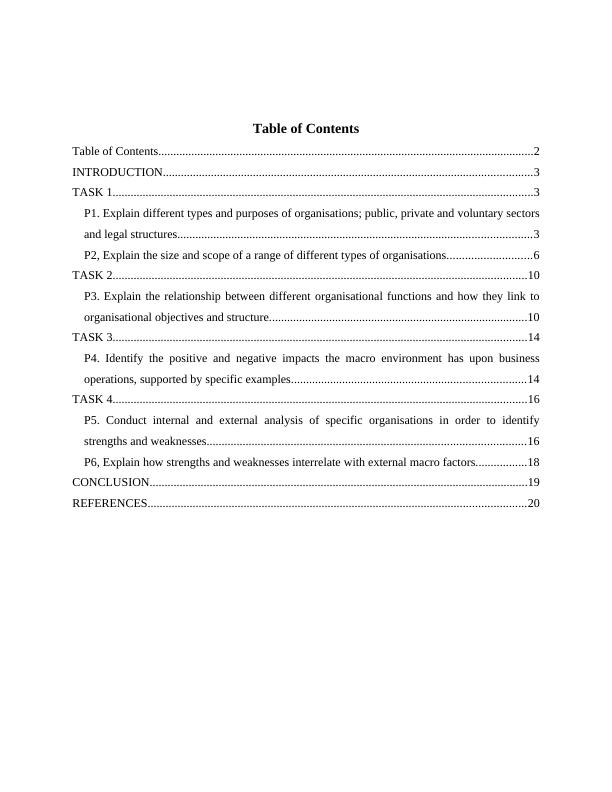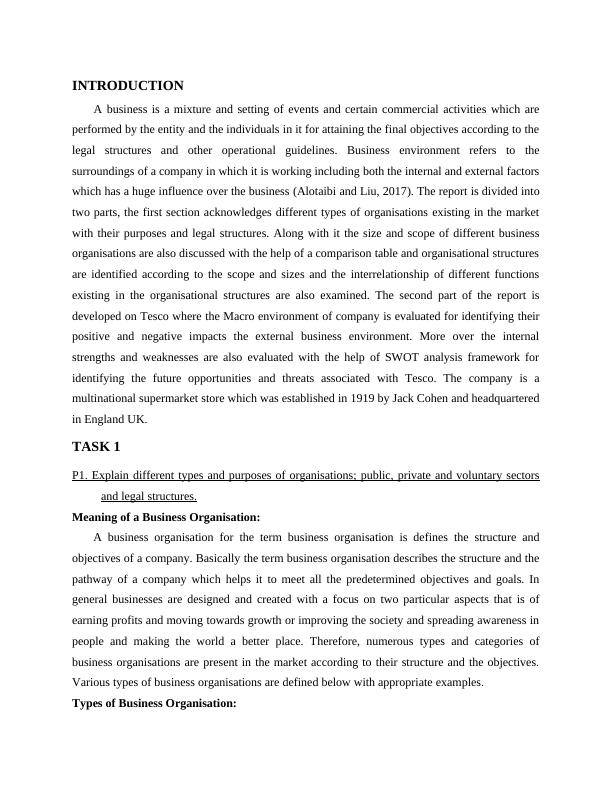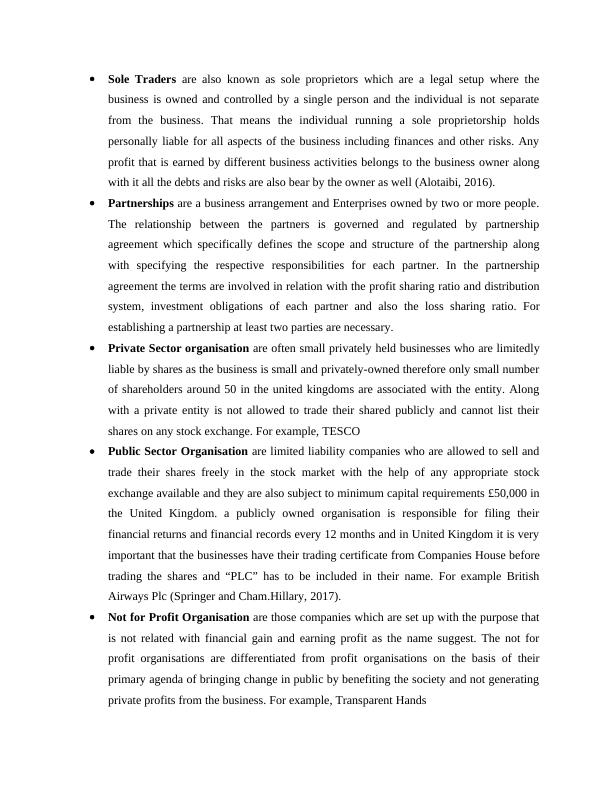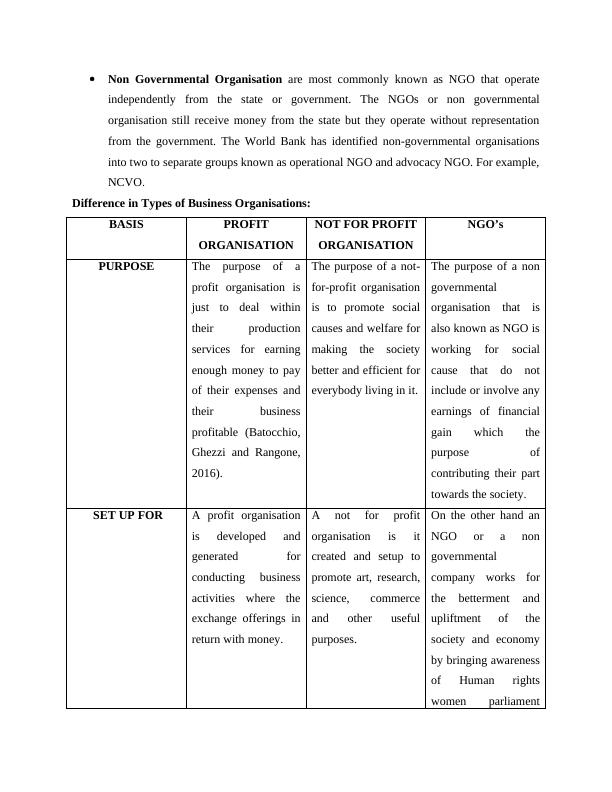Types and Purposes of Organisations; Size and Scope of Different Types of Organisations
Added on 2023-01-11
23 Pages5519 Words63 Views
Business and the
Business Environment
Business Environment

Table of Contents
Table of Contents.............................................................................................................................2
INTRODUCTION...........................................................................................................................3
TASK 1............................................................................................................................................3
P1. Explain different types and purposes of organisations; public, private and voluntary sectors
and legal structures......................................................................................................................3
P2, Explain the size and scope of a range of different types of organisations............................6
TASK 2..........................................................................................................................................10
P3. Explain the relationship between different organisational functions and how they link to
organisational objectives and structure......................................................................................10
TASK 3..........................................................................................................................................14
P4. Identify the positive and negative impacts the macro environment has upon business
operations, supported by specific examples..............................................................................14
TASK 4..........................................................................................................................................16
P5. Conduct internal and external analysis of specific organisations in order to identify
strengths and weaknesses..........................................................................................................16
P6, Explain how strengths and weaknesses interrelate with external macro factors.................18
CONCLUSION..............................................................................................................................19
REFERENCES..............................................................................................................................20
Table of Contents.............................................................................................................................2
INTRODUCTION...........................................................................................................................3
TASK 1............................................................................................................................................3
P1. Explain different types and purposes of organisations; public, private and voluntary sectors
and legal structures......................................................................................................................3
P2, Explain the size and scope of a range of different types of organisations............................6
TASK 2..........................................................................................................................................10
P3. Explain the relationship between different organisational functions and how they link to
organisational objectives and structure......................................................................................10
TASK 3..........................................................................................................................................14
P4. Identify the positive and negative impacts the macro environment has upon business
operations, supported by specific examples..............................................................................14
TASK 4..........................................................................................................................................16
P5. Conduct internal and external analysis of specific organisations in order to identify
strengths and weaknesses..........................................................................................................16
P6, Explain how strengths and weaknesses interrelate with external macro factors.................18
CONCLUSION..............................................................................................................................19
REFERENCES..............................................................................................................................20

INTRODUCTION
A business is a mixture and setting of events and certain commercial activities which are
performed by the entity and the individuals in it for attaining the final objectives according to the
legal structures and other operational guidelines. Business environment refers to the
surroundings of a company in which it is working including both the internal and external factors
which has a huge influence over the business (Alotaibi and Liu, 2017). The report is divided into
two parts, the first section acknowledges different types of organisations existing in the market
with their purposes and legal structures. Along with it the size and scope of different business
organisations are also discussed with the help of a comparison table and organisational structures
are identified according to the scope and sizes and the interrelationship of different functions
existing in the organisational structures are also examined. The second part of the report is
developed on Tesco where the Macro environment of company is evaluated for identifying their
positive and negative impacts the external business environment. More over the internal
strengths and weaknesses are also evaluated with the help of SWOT analysis framework for
identifying the future opportunities and threats associated with Tesco. The company is a
multinational supermarket store which was established in 1919 by Jack Cohen and headquartered
in England UK.
TASK 1
P1. Explain different types and purposes of organisations; public, private and voluntary sectors
and legal structures.
Meaning of a Business Organisation:
A business organisation for the term business organisation is defines the structure and
objectives of a company. Basically the term business organisation describes the structure and the
pathway of a company which helps it to meet all the predetermined objectives and goals. In
general businesses are designed and created with a focus on two particular aspects that is of
earning profits and moving towards growth or improving the society and spreading awareness in
people and making the world a better place. Therefore, numerous types and categories of
business organisations are present in the market according to their structure and the objectives.
Various types of business organisations are defined below with appropriate examples.
Types of Business Organisation:
A business is a mixture and setting of events and certain commercial activities which are
performed by the entity and the individuals in it for attaining the final objectives according to the
legal structures and other operational guidelines. Business environment refers to the
surroundings of a company in which it is working including both the internal and external factors
which has a huge influence over the business (Alotaibi and Liu, 2017). The report is divided into
two parts, the first section acknowledges different types of organisations existing in the market
with their purposes and legal structures. Along with it the size and scope of different business
organisations are also discussed with the help of a comparison table and organisational structures
are identified according to the scope and sizes and the interrelationship of different functions
existing in the organisational structures are also examined. The second part of the report is
developed on Tesco where the Macro environment of company is evaluated for identifying their
positive and negative impacts the external business environment. More over the internal
strengths and weaknesses are also evaluated with the help of SWOT analysis framework for
identifying the future opportunities and threats associated with Tesco. The company is a
multinational supermarket store which was established in 1919 by Jack Cohen and headquartered
in England UK.
TASK 1
P1. Explain different types and purposes of organisations; public, private and voluntary sectors
and legal structures.
Meaning of a Business Organisation:
A business organisation for the term business organisation is defines the structure and
objectives of a company. Basically the term business organisation describes the structure and the
pathway of a company which helps it to meet all the predetermined objectives and goals. In
general businesses are designed and created with a focus on two particular aspects that is of
earning profits and moving towards growth or improving the society and spreading awareness in
people and making the world a better place. Therefore, numerous types and categories of
business organisations are present in the market according to their structure and the objectives.
Various types of business organisations are defined below with appropriate examples.
Types of Business Organisation:

Sole Traders are also known as sole proprietors which are a legal setup where the
business is owned and controlled by a single person and the individual is not separate
from the business. That means the individual running a sole proprietorship holds
personally liable for all aspects of the business including finances and other risks. Any
profit that is earned by different business activities belongs to the business owner along
with it all the debts and risks are also bear by the owner as well (Alotaibi, 2016).
Partnerships are a business arrangement and Enterprises owned by two or more people.
The relationship between the partners is governed and regulated by partnership
agreement which specifically defines the scope and structure of the partnership along
with specifying the respective responsibilities for each partner. In the partnership
agreement the terms are involved in relation with the profit sharing ratio and distribution
system, investment obligations of each partner and also the loss sharing ratio. For
establishing a partnership at least two parties are necessary.
Private Sector organisation are often small privately held businesses who are limitedly
liable by shares as the business is small and privately-owned therefore only small number
of shareholders around 50 in the united kingdoms are associated with the entity. Along
with a private entity is not allowed to trade their shared publicly and cannot list their
shares on any stock exchange. For example, TESCO
Public Sector Organisation are limited liability companies who are allowed to sell and
trade their shares freely in the stock market with the help of any appropriate stock
exchange available and they are also subject to minimum capital requirements £50,000 in
the United Kingdom. a publicly owned organisation is responsible for filing their
financial returns and financial records every 12 months and in United Kingdom it is very
important that the businesses have their trading certificate from Companies House before
trading the shares and “PLC” has to be included in their name. For example British
Airways Plc (Springer and Cham.Hillary, 2017).
Not for Profit Organisation are those companies which are set up with the purpose that
is not related with financial gain and earning profit as the name suggest. The not for
profit organisations are differentiated from profit organisations on the basis of their
primary agenda of bringing change in public by benefiting the society and not generating
private profits from the business. For example, Transparent Hands
business is owned and controlled by a single person and the individual is not separate
from the business. That means the individual running a sole proprietorship holds
personally liable for all aspects of the business including finances and other risks. Any
profit that is earned by different business activities belongs to the business owner along
with it all the debts and risks are also bear by the owner as well (Alotaibi, 2016).
Partnerships are a business arrangement and Enterprises owned by two or more people.
The relationship between the partners is governed and regulated by partnership
agreement which specifically defines the scope and structure of the partnership along
with specifying the respective responsibilities for each partner. In the partnership
agreement the terms are involved in relation with the profit sharing ratio and distribution
system, investment obligations of each partner and also the loss sharing ratio. For
establishing a partnership at least two parties are necessary.
Private Sector organisation are often small privately held businesses who are limitedly
liable by shares as the business is small and privately-owned therefore only small number
of shareholders around 50 in the united kingdoms are associated with the entity. Along
with a private entity is not allowed to trade their shared publicly and cannot list their
shares on any stock exchange. For example, TESCO
Public Sector Organisation are limited liability companies who are allowed to sell and
trade their shares freely in the stock market with the help of any appropriate stock
exchange available and they are also subject to minimum capital requirements £50,000 in
the United Kingdom. a publicly owned organisation is responsible for filing their
financial returns and financial records every 12 months and in United Kingdom it is very
important that the businesses have their trading certificate from Companies House before
trading the shares and “PLC” has to be included in their name. For example British
Airways Plc (Springer and Cham.Hillary, 2017).
Not for Profit Organisation are those companies which are set up with the purpose that
is not related with financial gain and earning profit as the name suggest. The not for
profit organisations are differentiated from profit organisations on the basis of their
primary agenda of bringing change in public by benefiting the society and not generating
private profits from the business. For example, Transparent Hands

Non Governmental Organisation are most commonly known as NGO that operate
independently from the state or government. The NGOs or non governmental
organisation still receive money from the state but they operate without representation
from the government. The World Bank has identified non-governmental organisations
into two to separate groups known as operational NGO and advocacy NGO. For example,
NCVO.
Difference in Types of Business Organisations:
BASIS PROFIT
ORGANISATION
NOT FOR PROFIT
ORGANISATION
NGO’s
PURPOSE The purpose of a
profit organisation is
just to deal within
their production
services for earning
enough money to pay
of their expenses and
their business
profitable (Batocchio,
Ghezzi and Rangone,
2016).
The purpose of a not-
for-profit organisation
is to promote social
causes and welfare for
making the society
better and efficient for
everybody living in it.
The purpose of a non
governmental
organisation that is
also known as NGO is
working for social
cause that do not
include or involve any
earnings of financial
gain which the
purpose of
contributing their part
towards the society.
SET UP FOR A profit organisation
is developed and
generated for
conducting business
activities where the
exchange offerings in
return with money.
A not for profit
organisation is it
created and setup to
promote art, research,
science, commerce
and other useful
purposes.
On the other hand an
NGO or a non
governmental
company works for
the betterment and
upliftment of the
society and economy
by bringing awareness
of Human rights
women parliament
independently from the state or government. The NGOs or non governmental
organisation still receive money from the state but they operate without representation
from the government. The World Bank has identified non-governmental organisations
into two to separate groups known as operational NGO and advocacy NGO. For example,
NCVO.
Difference in Types of Business Organisations:
BASIS PROFIT
ORGANISATION
NOT FOR PROFIT
ORGANISATION
NGO’s
PURPOSE The purpose of a
profit organisation is
just to deal within
their production
services for earning
enough money to pay
of their expenses and
their business
profitable (Batocchio,
Ghezzi and Rangone,
2016).
The purpose of a not-
for-profit organisation
is to promote social
causes and welfare for
making the society
better and efficient for
everybody living in it.
The purpose of a non
governmental
organisation that is
also known as NGO is
working for social
cause that do not
include or involve any
earnings of financial
gain which the
purpose of
contributing their part
towards the society.
SET UP FOR A profit organisation
is developed and
generated for
conducting business
activities where the
exchange offerings in
return with money.
A not for profit
organisation is it
created and setup to
promote art, research,
science, commerce
and other useful
purposes.
On the other hand an
NGO or a non
governmental
company works for
the betterment and
upliftment of the
society and economy
by bringing awareness
of Human rights
women parliament

extra in the public
(Talamini and et. al.,
2013).
GOALS Tesco is the best
example of a profit
organisation the main
goal and aim of it is to
become the market
leader and maintain
its position in global
markets by
sustainable means.
Transparent hands is a
not for profits
company and holds
the first position in
top Five Trust
organisations in UK.
Its goal is to provide
healthcare services to
all those who are in
need. It is considered
as the easiest way for
saving people’s lives.
NCVO is an NGO
established with the
aim of helping all
voluntary
organisations to
flourish and move
further for making
bigger difference in
the society by
working together.
LEAGAL
STRUCTURE
Legal structure of
Tesco is easy and
flexible as company is
working with flat
hierarchical structure
providing it ease and
better competitiveness
in the marketplace.
The legal structure of
NPO’s are little
complex as
Transparent Hands
have to make sure to
comply with all legal
laws and regulation
provided by
government in order
to acquire prescribed
grants and rebates.
The legal structure of
a Voluntary entity like
NCVO is also
complex as most
countries have strict
laws and regulations
for such businesses
for reducing any
malpractices under the
name of an NGO.
P2, Explain the size and scope of a range of different types of organisations.
Difference between Micro, Small, Medium and Large Organisation:
BASIS MICRO SMALL MEDIUM LARGE
(Talamini and et. al.,
2013).
GOALS Tesco is the best
example of a profit
organisation the main
goal and aim of it is to
become the market
leader and maintain
its position in global
markets by
sustainable means.
Transparent hands is a
not for profits
company and holds
the first position in
top Five Trust
organisations in UK.
Its goal is to provide
healthcare services to
all those who are in
need. It is considered
as the easiest way for
saving people’s lives.
NCVO is an NGO
established with the
aim of helping all
voluntary
organisations to
flourish and move
further for making
bigger difference in
the society by
working together.
LEAGAL
STRUCTURE
Legal structure of
Tesco is easy and
flexible as company is
working with flat
hierarchical structure
providing it ease and
better competitiveness
in the marketplace.
The legal structure of
NPO’s are little
complex as
Transparent Hands
have to make sure to
comply with all legal
laws and regulation
provided by
government in order
to acquire prescribed
grants and rebates.
The legal structure of
a Voluntary entity like
NCVO is also
complex as most
countries have strict
laws and regulations
for such businesses
for reducing any
malpractices under the
name of an NGO.
P2, Explain the size and scope of a range of different types of organisations.
Difference between Micro, Small, Medium and Large Organisation:
BASIS MICRO SMALL MEDIUM LARGE

End of preview
Want to access all the pages? Upload your documents or become a member.
Related Documents
Types and Purposes of Organisationslg...
|18
|5329
|44
Different Types and Purposes of Organisationslg...
|20
|5518
|68
Types and Purposes of Organisations in Business Environmentlg...
|16
|5367
|85
Types and Purpose of Organisationslg...
|15
|4380
|96
Business and Business Environment: Types and Purposes of Organisations, Organisational Functions and Objectiveslg...
|17
|5137
|495
Exploring Different Types of Organisations and Their Functionslg...
|17
|5386
|50